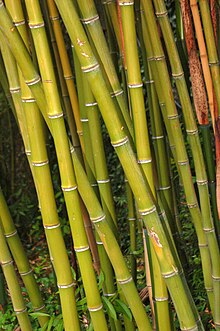
Summary
Phyllostachys bambusoides, commonly called madake, giant timber bamboo, or Japanese timber bamboo, is a species of flowering plant in the bamboo subfamily of the grass family Poaceae, native to China, and possibly also to Japan.[1]
| Phyllostachys bambusoides | |
|---|---|

| |
| Phyllostachys bambusoides at the botanical garden of Villa Durazzo-Pallavicini, Genova Pegli | |
| Scientific classification | |
| Kingdom: | Plantae |
| Clade: | Tracheophytes |
| Clade: | Angiosperms |
| Clade: | Monocots |
| Clade: | Commelinids |
| Order: | Poales |
| Family: | Poaceae |
| Genus: | Phyllostachys |
| Species: | P. bambusoides
|
| Binomial name | |
| Phyllostachys bambusoides Siebold & Zucc.
| |
| Synonyms | |
| |
Description edit
Phyllostachys bambusoides is a "running" (monopodial type) evergreen bamboo[1] which can reach a height of roughly 20 m (66 ft) and a diameter of 10 cm (3.9 in). The culms are dark green, with a thin wall that thickens with maturity, and very straight, with long internodes and two distinctive rings at the node.[2] The species is thin-skinned, easily split lengthwise, has long fibres, and is strong and highly flexible, even when split finely.[2]
Leaves are dark green, and the sheaths are strong and hairless. New stalks emerge in late spring and grow at a rate of up to 1 m (3 ft 3 in) a day; one specimen produced culms growing a remarkable 120 cm (47 in) in 24 hours.[3] The flowering interval of this species is very long, lasting roughly 120 years.[4][5]
Uses edit
In Asia, Phyllostachys bambusoides, known in Japan as madake, is one of the preferred bamboos for construction and furniture manufacture.[citation needed] Its properties also make it useful in a number of traditional Japanese arts and crafts:
- Both madake and Phyllostachys edulis (known in Japanese as moso) are used in the making of shakuhachi flutes[6][2]
- The hairless and flexible sheaths of madake - known as takekawa or takenokawa - make it apt for wrapping food, and in the production of baren woodblock printing tools.
- The uniform, plain-colour sheaths of the variety kashirodake were traditionally used to weave the coverings of some geta, a covering known as tatami omote; however, in modern times, the variety used is a different and unknown species, grown in China and bleached to be plain in colour.[7]
- The long internodes and equally long fibres of the bamboo make it ideal for traditional basket-weaving and the production of fans.
Phyllostachys bambusoides is cultivated as an ornamental plant in temperate zones worldwide, with numerous cultivars being available. Some grow to extreme lengths and heights, making them typically only suitable for parks and large gardens; however, more compact cultivars are available.
The following cultivars are recipients of the Royal Horticultural Society's Award of Garden Merit:[8]
Gallery edit
-
P. bambusoides 'Violascens'
-
P. bambusoides 'Holochrysa'
-
Branch of P. bambusoides
-
Leaf of 'P. bambusoides f castillonis
References edit
- ^ a b Brickell, Christopher, ed. (2008). The Royal Horticultural Society A-Z Encyclopedia of Garden Plants. United Kingdom: Dorling Kindersley. p. 811. ISBN 9781405332965.
- ^ a b c Bess, Nancy Moore; Wein, Bibi (2001). bamboo in japan (1st ed.). New York: Kodansha International. p. 34.
- ^ Robert Austin and Koichiro Ueda, BAMBOO (New York: Walker/Weatherhill, 1970) p. 193.
- ^ Veller, Carl; Nowak, Martin A.; Davis, Charles C. (July 2015). "Letter: Extended flowering intervals of bamboos evolved by discrete multiplication" (PDF). Ecology Letters. 18 (7): 653–659. doi:10.1111/ele.12442. ISSN 1461-023X. PMID 25963600. Archived from the original (PDF) on 2015-09-11. Retrieved April 1, 2016.
- ^ Carl Zimmer (May 15, 2015). "Bamboo Mathematicians". National Geographic. Archived from the original on May 17, 2015. Retrieved April 1, 2016.
- ^ Yung, Perry (2009). "What is madake bamboo?". www.yungflutes.com.
- ^ "雪駄(雪踏)についての考察~その24:雪駄表の製造工程". 魁!!雪駄塾 SAKIGAKE!!SETTA JYUKU. Retrieved 21 August 2019.
- ^ "AGM Plants – Ornamental" (PDF). Royal Horticultural Society. July 2017. p. 78. Retrieved 26 April 2018.
- ^ "RHS Plantfinder – Phyllostachys bambusoides 'Castillonii'". Retrieved 25 April 2018.
- ^ "RHS Plantfinder – Phyllostachys bambusoides 'Holochrysa'". Retrieved 25 April 2018.
- Bamboo Garden
- Complete bamboo
External links edit
- * "Phyllostachys bambusoides Siebold & Zucc". Tropicos.org. Missouri Botanical Garden. Retrieved 2012-07-30.


